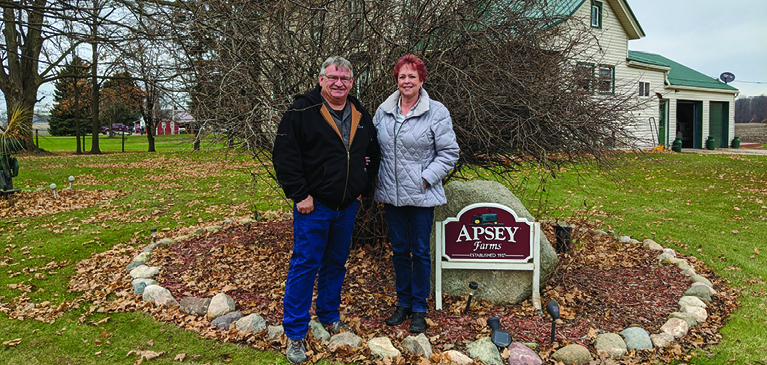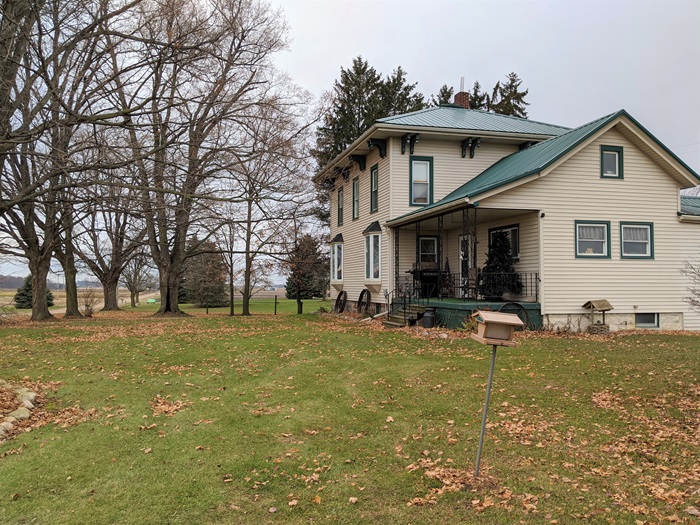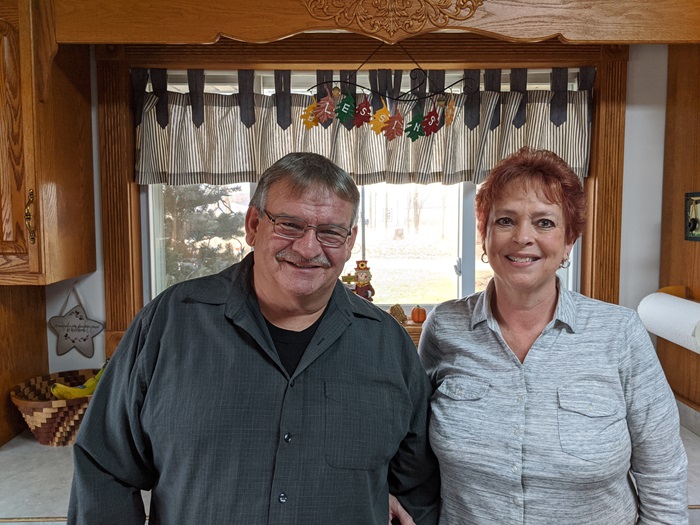
“Grandpa started it. He started the Apsey farm and worked it until he was 80.” Allen Apsey gestures toward the red barn and acreage beyond. “My dad took it over and I took it over from him in 1990. I’ve been farming ever since – really, farming ever since I was a little boy next to my dad and grandpa.”
Sitting at the dining room table in the house his grandpa purchased in the early 1900s, Allen is the embodiment of a family man with deep roots in Michigan agriculture and in his local community. Married for 43 years to Kathy, they’ve spent a lifetime in their solid farmhouse raising three children and enjoying their five young ‘grands.’
“My grandma actually farmed more than my grandpa did,” Allen adds. “Grandpa got in an accident; a car hit him and broke his back so my grandma did all the field work and hauled the grain.”
Kathy shook her head. “I don’t know how she ever did it, but after a day in the fields his grandma would bake for the church bake sales and show up with a tub full of pies and cookies. She cared for four children, she quilted, she had a huge garden, she canned – and they had 37 milk cows. She did it all.”
The old Apsey farmhouse is lovely, and has been updated with additions and modern conveniences without losing its original carved woodwork or sweeping views of the fields. The living room was the ‘parlor’ in the old days, and one of the upstairs bedrooms housed pigs having litters during cold weather. The original barn still stands, and a 130 year-old photograph of the barn-raising hangs on the dining room wall.

“We’re small farmers, about 880 acres. But we’ve kept all our land for the last 25 years which has been good,” Allen says. “We have good people and good neighbors.”
The farm has weathered many cycles of plantings, harvests, family passings and celebrations. At its heart, holding it all together, is the strong and steadfast partnership Allen and Kathy have with each other, and their faithful relationship with God.
The faith of many farmers has been tested over the past year, with weather that has delayed planting, destroyed crops and cut harvesting short. The stress of seeing a season of hard work and hard-earned money quite literally go under water, has worried farmers seeking proactive protection from crop insurance.
Kathy knows what her husband faced out on their acreage all summer long and she leans across the table to share their experience. With just two days in the field in May because of all the rain, Allen was forced to late-plant and hope for the best. This year, however, he made a decision to add a GAP policy to his regular crop insurance purchase and it turned out to be the ideal year to try out the extra coverage.
“Nowadays, with the way weather is changing, I would be scared not to have crop insurance,” Kathy says, her expression serious. “It’s too important to protect your bottom line. I think having crop insurance let Allen sleep a little sounder knowing even though he couldn’t get the crops in, it was going to be taken care of one way or another.”
GreenStone Crop Insurance Specialist Kristen King is the Apseys’ local agent. She walked Allen through the insurance decision-making process and he chose to switch gears a little this year: after reducing his revenue protection coverage down to 75 percent, he added a GAP policy. Although revenue protection and yield protection are the two most common forms of crop insurance, private insurance products like GAP, ICE and price-flex are also useful add-ons for farmers looking for personalized solutions.
“A GAP policy is above and beyond an underlying revenue or yield protection policy,” Kristen says. “If you get frustrated with your underlying policy not kicking in with a small loss of 10-15 bushels/acre, GAP is an option that can cover some of that deductible. GAP is a great risk management strategy to help protect your investment when Mother Nature throws a curve ball, as she repeatedly did in 2019.”
Allen appreciates the flexibility of GAP insurance, and to him the earlier coverage activation is worth the extra cost.
“I don’t mind spending the extra money,” Allen admits. “It’s more than paid my premium, and I think next year I’ll do 85% revenue protection and GAP. When I first heard about GAP I was leery, but Kristen talked to me about it and you know, I said I’m going to try it. It was a perfect year to step out and do it, because you don’t have to lose a lot of revenue for this thing to kick in. It’s really the best thing I ever did.”
Kristen advises farmers interested in private products to enhance their crop insurance to talk with a crop insurance specialist. Producers whose inputs are covered by their crop insurance policy and who are happy with the premium they are paying may not need additional coverage – but a discussion with a specialist on customized options could change a farm’s financial outcome.
For Allen Apsey, crop insurance keeps the farm viable the years that hard work and careful planning are wiped out by weather disasters. He has no plans to leave the field; agriculture is his life’s work and his family legacy.
“We had a lady at Walmart last night thank us for farming,” Allen offers. “First time that’s ever happened. She said if it wasn’t for you guys, none of us would eat! And she’s right. Shopping in grocery stores, people don’t connect Doritos or potato chips or beef with crops.”
Allen and Kathy smile at each other. Clearly, they’ve fielded their share of common farming misconceptions from community members over the years, and they are kindly determined to set the record straight. Agriculture is extraordinarily tough work. Agriculture keeps America fed.

“I’ve worked in construction and as a factory worker but none of those were for me,” Allen says.
“His love is the farm,” Kathy adds.
He nods. “It’s always been farming.”
VIEW MORE
For more information regarding topics covered in this article, visit the Risk Management blog post.
To view the article in the online 2020 Winter Partners Magazine, click here.


